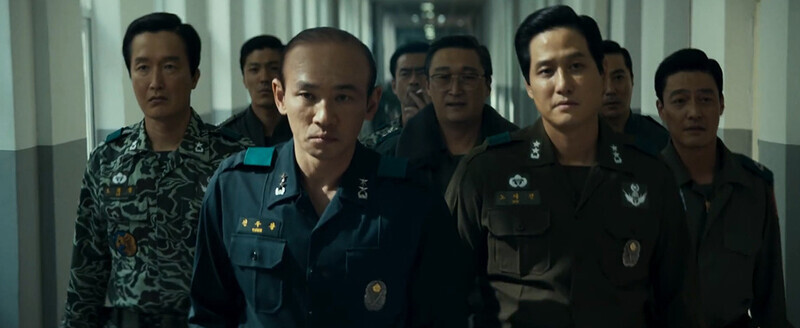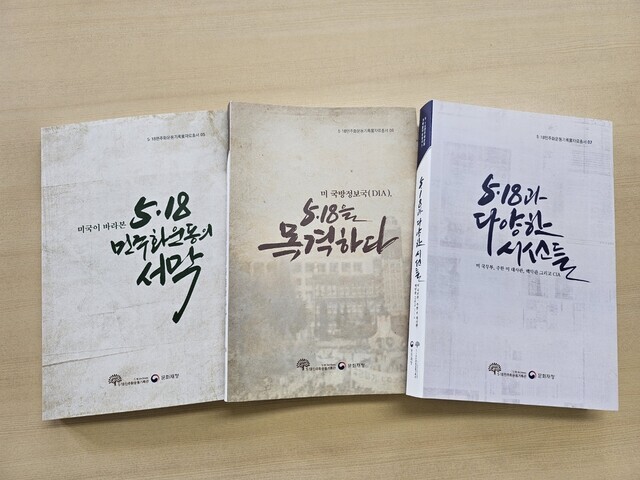hankyoreh
Links to other country sites 다른 나라 사이트 링크
Classified documents reveal Washington’s shifting perception of Chun’s 1979 mutiny

“We have been through a coup in all but name. The flabby facade of civilian constitutional government remains but almost all signs point to a carefully planned takeover of the military power positions by a group of ‘young Turk’ officers.”
— US Ambassador to South Korea William H. Gleysteen in communication to the US State Department at 9:27 am on Dec. 13, 1979
A recently published three-volume series of materials related to the democratization movement in Gwangju and the resulting massacre in May 1980 includes a striking series of documents composed by the US intelligence community around the time of the coup on Dec. 12, 1979. The series brings together American documents that were donated to the city of Gwangju in 2017 by Tim Shorrock, an American reporter.
These documents consist of cables that were urgently transmitted between the US Embassy in South Korea and the State Department during the events in Gwangju in May 1980, the minutes of meetings held by senior bureaucrats in the White House, military intelligence collected in utmost secrecy from various corners of Korean society by the Defense Intelligence Agency, and CIA analyses of how the US government ought to respond to the forces behind the coup, including Chun Doo-hwan.

The documents in this series confirm that the US was aware of the coup being organized by politically motivated soldiers on Dec. 12, 1979.
A US State Department document dated 7:51 pm on Dec. 12 says, “An incipient coup d’etat is in progress in Seoul,” going on to say: “In the early evening hours December 12 Seoul time (early morning Washington time), a group of ROK army officers centered apparently on Defense Security Force Commander General Chon Tu-hwan [Chun Doo-Hwan] and First Corps Commander Lt. Gen. Hwang Yong-si [Hwang Young-si], arrested Army Chief Of Staff and Martial Law Commander General Chung Sung-hwa [Jeong Seung-hwa].”
The US intelligence community referred to Chun’s clique by various names that symbolize the US’ changing perspective on the coup.
At 7:51 pm on Dec. 12, 1979, the US Department of State wrote, “General Chon has met with President Choi, and at one point tried to get Minister Ro [Roh Jae-hyeon, defense minister] and the other senior commanders to come to the presidency to ‘discuss replacement of the martial law commander.’”
“Minister Ro declined this invitation, fearing that he would become a hostage of the incipient coup forces,” the report states.
Here, Chun Doo-hwan’s forces were labeled as “coup forces.”
However, in a report written two days later, the same forces are referred to as “a new line-up” and “young Turk officers.”
A report made by the US Embassy in Seoul at 8:03 am on Dec. 13, 1979, states, “More than ever he [President Choi Kyu-hah] is cut off from support and dependent upon a new line-up within the ROK military establishment.”
At 9:27 am on the same day, the embassy sent a report referring to those taking power of the military as “a group of ‘young Turk’ officers.”
“Turk” is slang used to refer to insurgents or troublemakers.
A US intelligence report on Dec. 13 uses the phrases “new military group” and “new military hierarchy.” A different phrase, “new army leadership group,” appears in a report made on Jan. 26, 1980. The coup forces were thusly upgraded from the initial “troublemakers” to “new army leadership group.”

The reports also cover in detail how South Korea’s defense minister at the time tried to flee from the military mutiny on Dec. 12, 1979. An US Department of State document said that Defense Minister Roh Jae-hyeon, Joint Chiefs Chairman Gen. Kim Jong-hwan and Combined Forces Commander Gen. Lew Byong-hion had been until a short time before sending, physically in the UN Command bunker at Yongsan along with UNC Commander Gen. Wickham and Ambassador Gleysteen. (Report sent by the US Department of State to the US ambassador in Seoul at 4:51 am on Dec. 13, 1979.)
Lee Jae-eui, a researcher of the Gwangju democratization movement who edited the volumes, commented, “Many documents detailing the actions of Chun Doo-hwan difficult to find in South Korean documents are included, which makes me excited about the fact that many researchers will be able to delve deeper in their research and unearth new truths.”
By Jung Dae-ha, Gwangju correspondent
Please direct questions or comments to [english@hani.co.kr]

Editorial・opinion
![[Guest essay] Preventing Korean Peninsula from becoming front line of new cold war [Guest essay] Preventing Korean Peninsula from becoming front line of new cold war](https://flexible.img.hani.co.kr/flexible/normal/500/300/imgdb/original/2024/0507/7217150679227807.jpg) [Guest essay] Preventing Korean Peninsula from becoming front line of new cold war
[Guest essay] Preventing Korean Peninsula from becoming front line of new cold war![[Column] The state is back — but is it in business? [Column] The state is back — but is it in business?](https://flexible.img.hani.co.kr/flexible/normal/500/300/imgdb/original/2024/0506/8217149564092725.jpg) [Column] The state is back — but is it in business?
[Column] The state is back — but is it in business?- [Column] Life on our Trisolaris
- [Editorial] Penalties for airing allegations against Korea’s first lady endanger free press
- [Editorial] Yoon must halt procurement of SM-3 interceptor missiles
- [Guest essay] Maybe Korea’s rapid population decline is an opportunity, not a crisis
- [Column] Can Yoon steer diplomacy with Russia, China back on track?
- [Column] Season 2 of special prosecutor probe may be coming to Korea soon
- [Column] Park Geun-hye déjà vu in Yoon Suk-yeol
- [Editorial] New weight of N. Korea’s nuclear threats makes dialogue all the more urgent
Most viewed articles
- 1Yoon’s broken-compass diplomacy is steering Korea into serving US, Japanese interests
- 2[Guest essay] Preventing Korean Peninsula from becoming front line of new cold war
- 3S. Korean first lady likely to face questioning by prosecutors over Dior handbag scandal
- 4Lee Jung-jae of “Squid Game” named on A100 list of most influential Asian Pacific leaders
- 5After 2 years in office, Yoon’s promises of fairness, common sense ring hollow
- 6Hybe-Ador dispute shines light on pervasive issues behind K-pop’s tidy facade
- 7Japan says it’s not pressuring Naver to sell Line, but Korean insiders say otherwise
- 8[Column] The state is back — but is it in business?
- 9Amid US-China clash, Korea must remember its failures in the 19th century, advises scholar
- 10[Editorial] Japan’s removal of forced labor memorial tramples on remembrance, reflection and friends